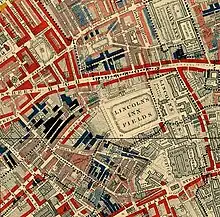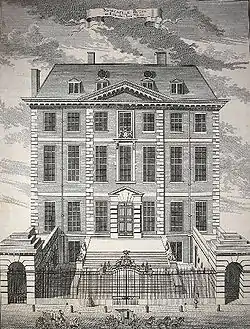Lincoln's Inn Fields


Lincoln's Inn Fields is the largest public square in London. It was laid out in the 1630s under the initiative of the speculative builder and contractor William Newton, "the first in a long series of entrepreneurs who took a hand in developing London", as Sir Nikolaus Pevsner observes.[1] The original plan for "laying out and planting" these fields, drawn by the hand of Inigo Jones, was said still to be seen in Lord Pembroke's collection at Wilton House in the 19th century,[2] but its location is now unknown.[3] The grounds, which had remained private property, were acquired by London County Council in 1895 and opened to the public by its chairman, Sir John Hutton, the same year.[4] The square is today managed by the London Borough of Camden and forms part of the southern boundary of that borough with the City of Westminster.[5]
Lincoln's Inn Fields takes its name from the adjacent Lincoln's Inn, of which the private gardens are separated from the Fields by a perimeter wall and a large gatehouse.
The grassed area in the centre of the Fields contains a court for tennis and netball, and a bandstand. It was previously used for corporate events, which are no longer permitted. Cricket and other sports are thought to have been played here in the 18th century.

History

Lincoln's Inn was situated in the county of Middlesex. Up to the 17th century cattle were grazed upon the fields, which were part of the Holborn grassland named Pursefield and belonged to St Giles Hospital. In the report of excavations of 64 Lincoln's Inn Fields,[6] it is noted that one Katherine Smyth, the owner of the White Hart Inn on Drury Lane, leased the land from 1520. It then reverted to the Crown, and was used as pasture and occasionally for an execution.
The use of the pastures meant that turnstiles were placed around the square to enable pedestrians to enter without the animals escaping. Shops and other businesses developed along these footpaths, and some of these alleys still exist – the Great and Little Turnstile.[7]
Schemes for redevelopment of the fields by Inigo Jones and Charles Cornwallis in 1613 and 1618 were unsuccessful. William Newton gained permission, however, to erect 32 houses in what became known as Lincoln's Inn Fields in 1638 for an annual fee of £5 6s 8d. However, the building licence was only given if the central area remained an outdoor space open to the public. Quarry pits were discovered in the excavations at No. 64 (see above), probably for building materials, in particular, gravel. In the fill of one was a fragment of a 'fuddling cup', a drinking vessel which made it deliberately difficult to drink from without spillage.
When originally laid out, Lincoln's Inn Fields was part of fashionable London. The completion of the houses that surrounded it proceeded at a leisurely pace, interrupted by the English Civil War. In 1659 James Cooper, Robert Henley, and Francis Finch and other owners of "certain parcels of ground in the fields, commonly called Lincoln's Inn Fields", were exempted from all forfeitures and penalties which they might incur in regard to any new buildings they might erect on three sides of the same fields, previously to 1 October in that year, provided that they paid for the public service one year's full value for every such house within one month of its erection; and provided that they should convey the "residue of the said fields" to the Society of Lincoln's Inn, for laying the same into walks for common use and benefit, whereby the annoyances which formerly have been in the same fields will be taken away, and passengers there for the future better secured."[8] The oldest building from this early period is Lindsey House, 59–60 Lincoln's Inn Fields, which was built in 1640 and has been attributed to Inigo Jones.[9] The builder may have been David Cunningham, 1st Baronet of Auchinhervie, a friend of the mason-sculptor Nicholas Stone, who also supervised the rebuilding of Berkhamsted Place for Charles I.[10] It derives its name from a period of ownership in the 18th century by the earls of Lindsey.[11]

Another seventeenth-century survival is now 66 Lincoln's Inn Fields, which was built for Lord Powis and known as Powis House. The charter of the Bank of England was sealed there on 27 July 1694. It was in 1705 acquired by the Duke of Newcastle (whereupon it became known as Newcastle House) who had it remodelled by Sir John Vanbrugh (following earlier work by Christopher Wren after a fire in 1684). It remains substantially in its form of c. 1700, although a remodelling in 1930 by Edwin Lutyens gives it a curiously pastiche appearance.
As London fashion moved west, Lincoln's Inn Fields was left to rich lawyers who were attracted by its proximity to the Inns of Court. In this way the former Newcastle House became in 1790 the premises of the firm of solicitors Farrer & Co, which is still there: their clients include Queen Elizabeth II.
The Lincoln's Inn Fields Theatre was located in the Fields from 1661 to 1848, when it was demolished. This, originally called the Duke's Theatre, was created by converting Lisle's Tennis Court in 1695. The theatre presented the first paid public performances of Henry Purcell's Dido and Aeneas in 1700, John Gay's The Beggar's Opera in January 1728, and George Frideric Handel's final two operas in 1740 and 1741.
Lincoln's Inn Fields was the site, in 1683, of the public beheading of Lord William Russell, son of the first Duke of Bedford, following his implication in the Rye House Plot for the attempted assassination of King Charles II. The executioner was Jack Ketch, who made such a poor job of it that four axe blows were required before the head was separated from the body; after the first stroke, Russell looked up and said to him "You dog, did I give you 10 guineas to use me so inhumanely?".
Sometime after 1735 the Fields were enclosed within an iron railing, on account of the then Master of the Rolls, Sir Joseph Jekyll, being ridden over by a horse. An alternative version of the story claims that Jekyll was attacked for his support of an Act of Parliament raising the price of gin.[12]
From 1750 to 1992, the solicitors Frere Cholmeley were in premises on the north side of Lincoln's Inn Fields, after which their buildings were taken over by a leading set of commercial barristers' chambers, known as Essex Court Chambers after their own former premises at 4 Essex Court in the Temple. Essex Court Chambers now occupy five buildings, nos. 24–28 Lincoln's Inn Fields. Other barristers' chambers, including leading family law chambers 1GC Family Law, have since then also set up in Lincoln's Inn Fields, but solicitors' firms still outnumber them there.

In Charles Dickens' novel Bleak House, the sinister solicitor to the aristocracy, Mr Tulkinghorn, has his offices in Lincoln's Inn Fields, and one of its most dramatic scenes is set there. The description of his building corresponds most closely to Lindsey House. After a spell of being occupied by a firm of patent agents, Lindsey House has become home to the leading civil liberties barristers' chambers, Garden Court Chambers, together with the neighbouring building at 57–58, which includes some features designed by Sir John Soane, including a geometric staircase.[13]
The London School of Economics and Political Science moved onto the square in 2003, taking the leasehold of 50 Lincoln's Inn Fields, on the corner of Sardinia Street. At the end of 2008, a new £71 million state-of-the-art building housing the LSE's Departments of Law and Management (54 Lincoln's Inn Fields) was opened by the Queen and the Duke of Edinburgh. Since then it has taken ownership of Sardinia House (2009), the former Land Registry building at 32 Lincoln's Inn Fields (2010), 44 Lincoln's Inn Fields (previously the home of Cancer Research), 5 Lincoln's Inn Fields (2016) and Nuffield House (2017), to expand to seven its portfolio of buildings on the square.
Notable premises


Aside from Lindsey House and Powis House, the north side of the square features Sir John Soane's Museum, home of the architect, at numbers 12, 13 and 14. On the same side, at number 7, is Thomas More Chambers, led by Geoffrey Cox QC MP.[14] Organisations with premises on the south side of the square include the London School of Economics and Political Science (LSE) and the Royal College of Surgeons (including the Hunterian Museum, in which are exhibited the intriguing medical collections of John Hunter). There is a blue plaque marking the home of the surgeon William Marsden at number 65. On the west side the Royal College of Radiologists has premises at 63 Lincoln's Inn Fields, and the London School of Economics and Political Science owns a number of buildings. Aside from the Royal College of Surgeons, the School will then own the entire south side of the square. There is a statue by Barry Flanagan, an abstract called Camdonian, in the north-east corner of the square. Also located at 67–69 is the Centre for Commercial Law Studies, the commercial law research and teaching centre of Queen Mary, University of London.
Homelessness
During the 1980s Lincoln's Inn Fields attracted many homeless people, who slept there overnight. In 1992, they were cleared out and fences were raised, and since the re-opening of Lincoln's Inn Fields with its new railings in 1993, gates have been locked every night at dusk.[15]
During the 2008 Muslim holy month of Ramadan, Muslims attended the Fields at sunset to feed the homeless.[16]
Nearest stations
The nearest London Underground stations are Holborn, Chancery Lane and Temple.
References
- Pevsner, London: The Cities of London and Westminster, vol. I (The Buildings of England), (1957) 1962:55.
- "Lincoln's Inn Fields", Old and New London: Volume 3 (1878), pp. 44–50. Retrieved 16 July 2010.
- It is not mentioned in the modern literature on Inigo Jones.
- "Opening of Lincoln's Inn Fields by Sir John Hutton, Chairman of the Council, on Saturday, 23rd February, 1895, at 2.30 p.m." www.wellcomecollection.org. Retrieved 9 April 2021.
- "Lincoln's Inn, Camden/Westminster". Hidden London. Hidden London. Retrieved 25 May 2023.
- Brederova, Barbora, "Post-Medieval urbanisation in Holborn: excavations at 64 Lincoln's Inn Fields, WC2". London Archaeologist, spring 2019, pp. 224–229
- Cunningham, Peter (1850), Handbook of London: Past and Present, vol. 1, J. Murray, p. 513
- Charles Knight, History of London, quoted in Survey of London
- Colen Campbell reported this tradition in Vitruvius Britannicus, I, p. 5, and illustrated it in plates 49, 50.
- Colvin, Howard, Essays, ix (1999): NAS GD237/25/1/7
- Lincoln's Inn Fields: Nos. 59 and 60 (Lindsey House), Survey of London: volume 3: St Giles-in-the-Fields, pt I: Lincoln's Inn Fields (1912), pp. 96–103]. Retrieved 22 May 2008.
- Timbs, John (1855). Curiosities of London: Exhibiting the Most Rare and Remarkable Objects of Interest in the Metropolis. D. Bogue. p. 528.
- Garden Court Chambers
- Thomas More Chambers
- History of Lincoln's Inn Fields – Camden Council Archived 11 June 2011 at the Wayback Machine
- Sarfraz Manzoor: How Muslim flashmobs can feed homeless people | The Guardian
Further reading
- Chancellor, Edwin Beresford, The Romance of Lincoln's Inn Fields, London: Richards, 1932 (2nd edition).
- Plantamura, Carol, The Opera Lover's Guide to Europe, New York: Citadel Press, 1996. ISBN 0-8065-1842-1
- Lincoln's Inn Fields, Old and New London: Volume 3 (1878), pp. 44–50.
- Manzoor, Sarfraz. "How Muslim flashmobs can feed homeless people", The Guardian, 22 September 2008.

